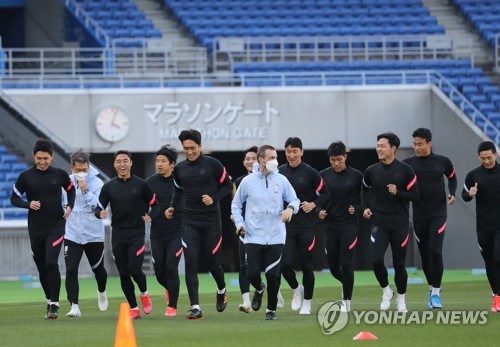Haniljeon D-1 Bento, quenching in tension… Focus on’Fast Pass’ in Japan
Official training of both national teams at Nissan Stadium to be played tomorrow

(Yokohama = Yonhap News) Correspondent Lee Se-won = One day ahead of the 80th Korea-Japan match in total, the soccer teams of both countries checked their skills at the same stadium with a time difference.
During the official training session released to the media, perhaps because of being conscious of the heaviness of Korea and Japan amid the absence of major players, the’Bento’ focused on physical training amid tension.
On the other hand, the Japanese team devoted a lot of time to fast pass training in a relatively light atmosphere.

On the afternoon of the 24th, the Korean soccer team led by coach Paulo Bento trained for the third day after arriving in Japan at the Nissan Stadium in Yokohama, Kanagawa Prefecture, Japan.
After arriving in Japan, I practiced at another playground in Yokohama for two days before, but the final inspection was done at the stadium where the actual game will be played the next day.
Korean players had relatively bright expressions until they entered the training ground and warmed up, but when training began in earnest, they looked quite tense than the day before.

I was overly conscious of the confrontation between Korea and Japan, a joke that’in Japan, even rock, paper, scissors should not be lost’, or the fact that the main players had to play in bad conditions while the main players were absent made me think that the shoulders were heavy. .
Director Bento said at an online press conference held just before the training that day, “I understand and respect Korea and Japan well. There are many difficulties, but it is important to bring good results.”
He added, “Rather than focusing on rivals, it’s more important to focus on what we can do and to prepare for how we can tackle it tactically.”

The training of the Korean team focused on warming up and reciprocating running using obstacles.
Except for goalkeeper Cho Hyun-woo and others, it was difficult to see the players hone their skills directly related to the actual battle.
While a number of Japanese media began to report on the scene, I wondered if it was a response to avoid exposure to tactics.

The Japanese national team officially trained in the same stadium an hour and a half after the Bento.
They stepped into the square line of the ground almost just at the promised 5:30 p.m., lined up and went around the field a few laps, stretching and balancing training, and then focused on passing practice.

Dividing the players into two groups, he repeatedly practiced very short and fast passes.
It is difficult to judge only the short part disclosed to the media, but it is estimated that it may be related to the game tactics on the 25th.

Japanese national team coach Hajime Moriyasu said at an online press conference held this morning, “I want to make it possible to make a quick attack so that I can make a goal, and if it is difficult to simply press the ball, I want to try to create a chance while moving the ball.”
He also explained the Korean team’s response strategy, saying, “It is necessary to be aggressive and brave from the beginning to overpower the opponent in the ball fight, and to actively go out.”

Looking at the released scenes, a large part of the training that lasted for three days for the Korean team was basic physical training, but most of the training for the Japanese team on this day was focused on the pass.
The expressions of Japanese athletes were very bright, whether it was because the training contents were different, or because the burden on the weight of Korea and Japan was less.
On this day, dozens of photojournalists and a number of reporters watched the preparations of both Korea and Japan.
The Korea-Japan Exhibition will start on the 25th at 7:20 pm at Nissan Stadium.
(End)
<저작권자(c) 연합뉴스, 무단 전재-재배포 금지>
